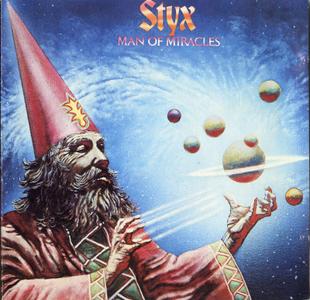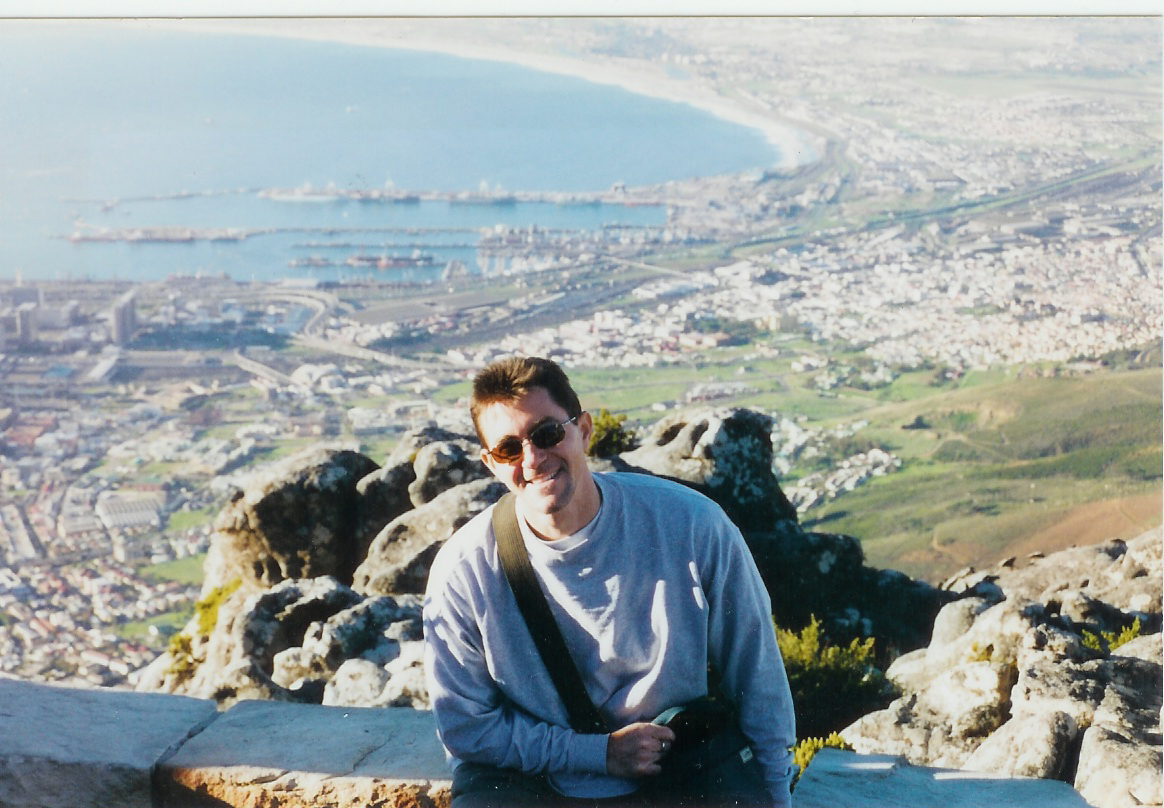Check back here for various and sundry updates.
______________________________________________________________________________________
4/2/18: Annual Las Vegas Trip
As has quickly become a tradition, my son and I visited Las Vegas for his spring break. Five nights at the Aria. Our show this trip was Terry Fator at the Mirage. I chose this performance because his puppets and ventriloquism supposedly appeal to both adults and kids. But the truth is that between the pop culture references and adorably innocent sexual innuendo, the adults in the audience seemed to have a better time. Not only was the show very funny, but Terry is also one of the most talented people I have ever seen take the stage. One odd observation: his Winston turtle puppet is considered a highlight of the act but I enjoyed the others more, especially the irascible cowboy.
In terms of Vegas gambling, I lost a few bucks except when I bet on opening day baseball. Don't ask why, but I had a premonition the underdog Rays would beat the Red Sox. They did.
My son and I visited Battlefield Vegas as well for a machine-gun shoot. I chose my standard Saving Private Ryan package for the third time. It's a good deal, and I just can't resist the hands-on history. My son's highlight was firing a mounted Browning 1919 machine gun. I think he liked it.
The obligatory Mandarin Sky Lobby picture:
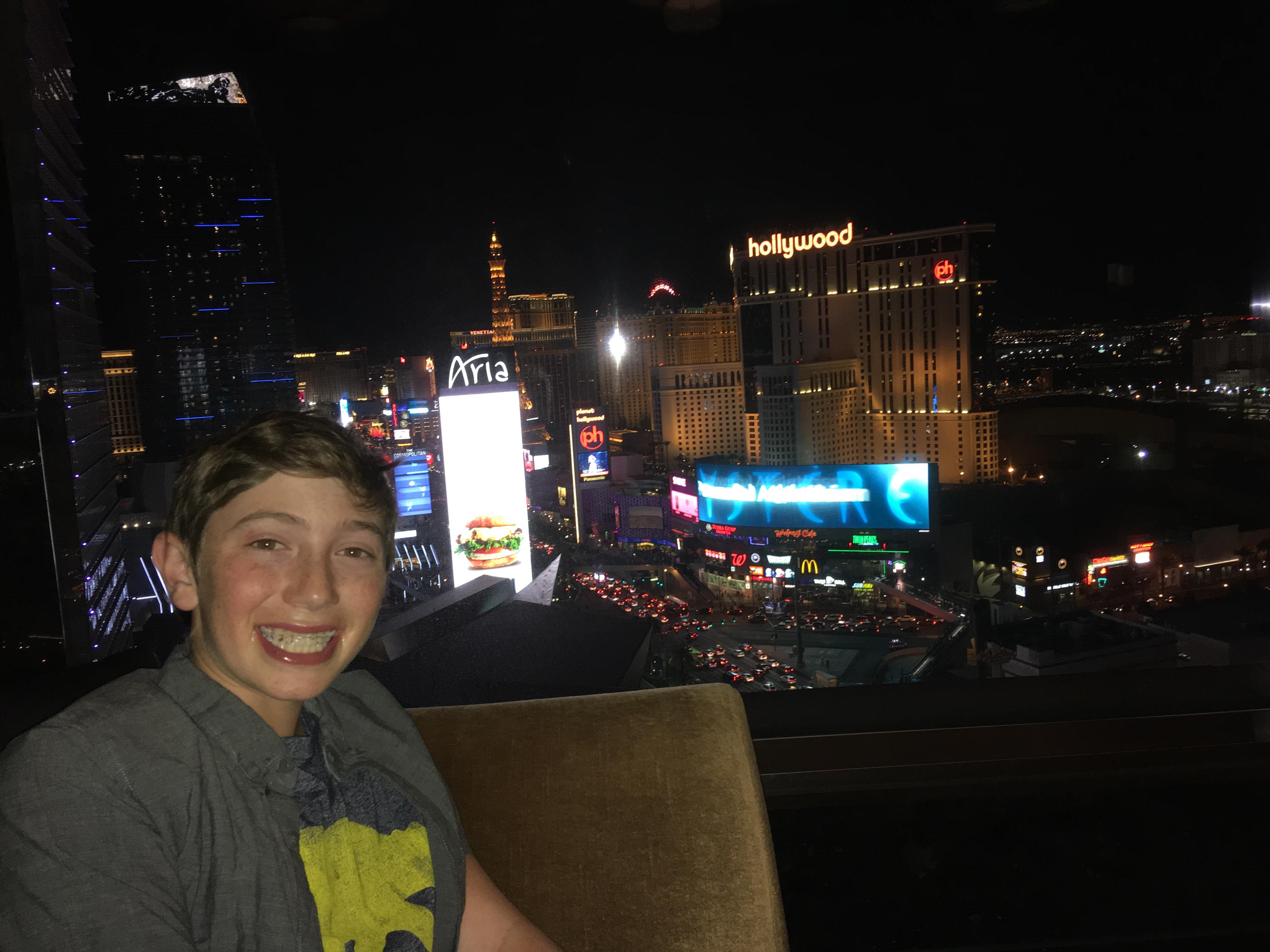
From the Bellagio walkway:
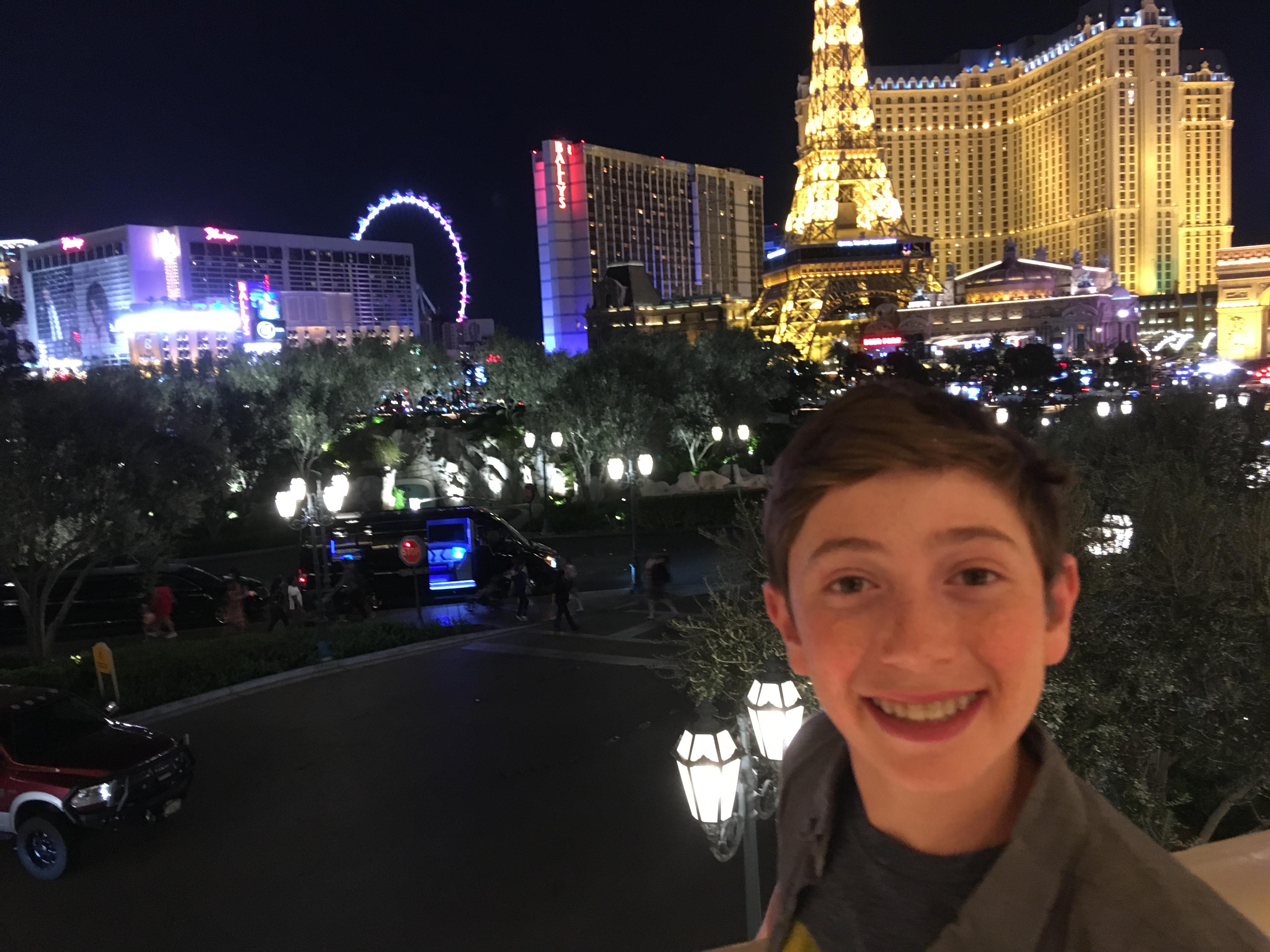
The Old Man at the Venetian piazza. My wife and I love this spot:
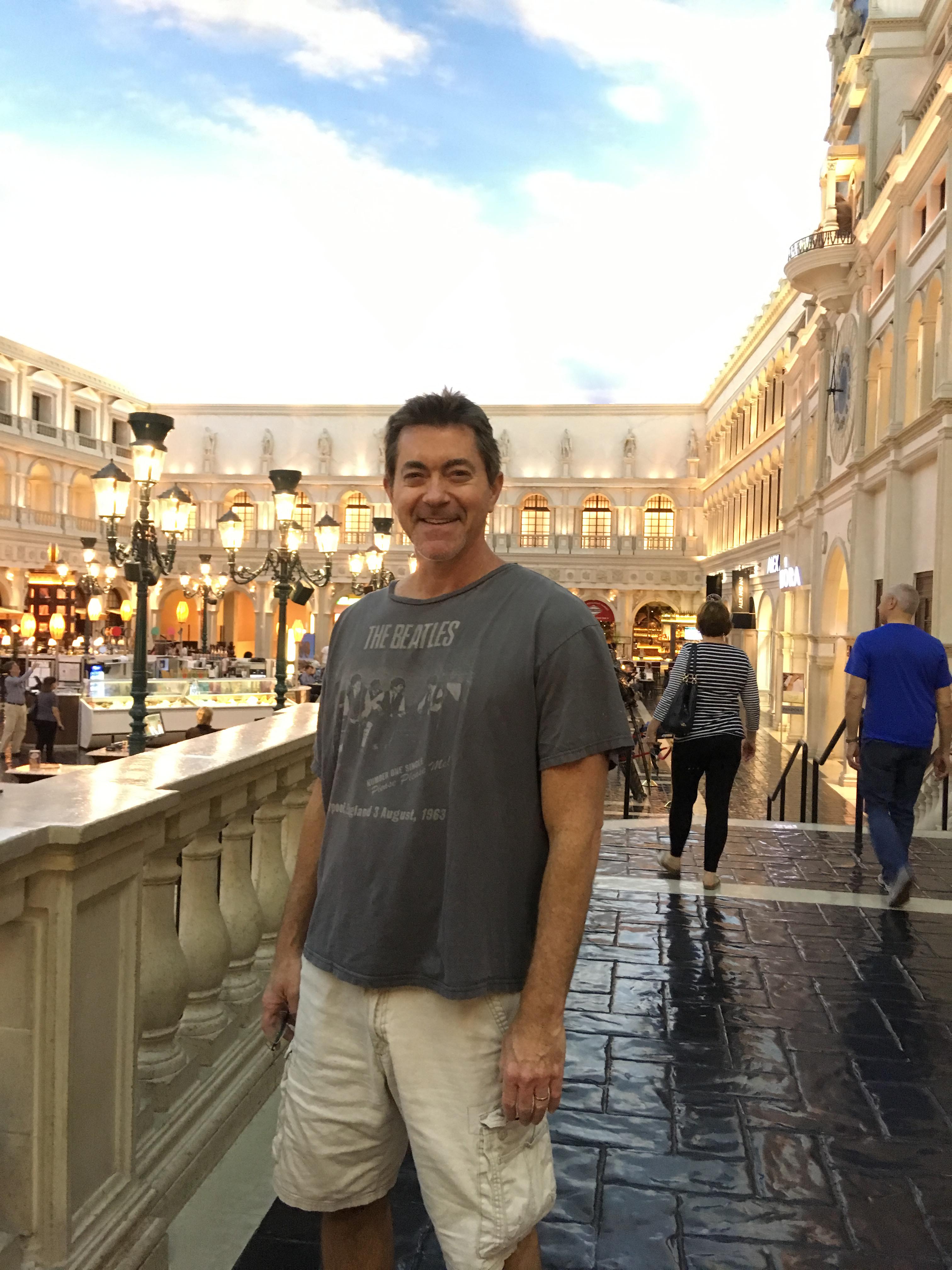
My son and I have come to hate the idea that Vegas goes on without us, but somehow it invariably does. Until next time...
3/15/18: Voyage To The Bottom Of The Sea
As in the "Complete Series DVD Set", that is. This was one of my favorite TV shows as a kid in the early 1970s, and I was interested to see how well it's aged. The answer is mixed. The series began in 1964 as a classic Cold War adventure, with spies, conspiracies, and enemies foreign and domestic, plus the overarching threat of nuclear Armageddon. However in Season Three the budget was cut and the producers decided to aim the show at young children like me. Suddenly the suspenseful Voyage became a dispiriting case of "Monster Of The Week", replete with bad writing and laughable special effects. A pity, since the cast was so wonderful (Richard Basehart and the gorgeous man-crush David Hedison, plus Bob Dowdell as Chip Morton and Del Monroe as every kid's favorite, the irreplaceable Kowalski). I'm halfway through Season Three and wish I could stop, but I won't give up now. Question: Did the Soviet Union, the Cold War, and imminent nuclear annihilation simply evaporate in 1966? Somehow I doubt it.
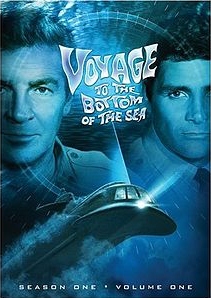
3/1/18: Discovering Agatha Christie
Though an avid reader, I've neglected until now to read any of Agatha Christie's mystery novels. The reason was simple: I had zero interest in the sleuthing adventures of an elderly British lady. But after all these years I decided to give Miss Jane Marple a try, and picked up The Mirror Crack'd from 1962. Though wishing to avoid hyperbole, The Mirror Crack'd is one of the best mystery novels I have ever read. Granted, Christie couldn't write like Chandler (after all, who can). But even taking into account all the false trails a good mystery will provide, the absolute last person I suspected ended up being the one who did it. Nothing like being fooled despite the fact that you're expecting it to happen.
2/5/18: Super Bowl 52
Well, exactly one year ago the Falcons learned what happens when you let the Patriots back in the game, even from a 25 point deficit. Two weeks ago the Jacksonville Jaguars reminded us that playing the Pats conservatively and trying not to lose is another sure way to lose. Yesterday the Philadelphia Eagles and coach Doug Pederson took that advice, and now they have Super Bowl rings to show for it.
Pederson's coaching was magnificent, and not just in the obvious ways. A perfect example was the 3rd and goal from the one yard line just before halftime. My football friend and I were texting each other, saying that this was exactly the situation that would prove whether the Eagles knew what they had to do to win this game. If they failed to score on 3rd down, then they MUST MUST MUST go for it on 4th down. NO field goals, because that is how to lose to New England. The 3rd down play failed. The 4th down play (which I assume you've seen a thousand times, but here it is) was a stunning trick call that scored a touchdown. Sure enough, commentators Al Michaels and Cris Collinsworth went on and on about how shocking this decision was -- proof that the mindset of knowledgeable football experts plays directly into the hands of coaches like Bill Belichick of New England. Then the Patriots scored a TD on their first possession of the second half, showing just how important that Eagles touchdown was. It's odd to believe that every serious football aficionado in the country understood that even while leading, the Eagles had no choice but to go for it on that fourth down play or lose the game for sure...while the so-called "experts" would have kicked a field goal, and most likely lost the Super Bowl.
1/20/18: New Remington .45
So a few weeks ago I read about a new line of 1911-style .45 pistols from Remington. The 1911 was John Browning's immortal pistol contribution to the American military, which served as the standard Army sidearm until the 1980s. (It was replaced by a Beretta 9mm, which many knowledgeable folks still consider a mistake.) I've never owned a model 1911. What I liked about the new Remington R1 Enhanced was the double-stack magazine -- 15 rounds instead of the standard 8. I had put in a request at Lou's to dig one up, but they couldn't get one for me. Then on Tuesday 1/16 I was searching for info on the pistol and found it for sale at Cheaper Than Dirt. Price was good too. I bought the pistol and for $10 they shipped it to Lou's for me to pick up after a background check. This is a beefy, solid pistol. I broke it in with cheap ammunition on Friday and plan to see how it behaves with better bullets.
1/6/18: Arizona Trip
From 12/25 to 1/5 I took the entire family to Arizona for my 50th birthday trip. We were planning to split the time between Las Vegas and Phoenix, but I decided to nix the five hour drive in favor of a night in Flagstaff and a visit to the Grand Canyon.
You can read about the wonderful Phoenician resort during our last trip, highlighted below. Temps were typically wonderful in Phoenix -- high 72, low 50. Flagstaff is at 7000 feet and much colder, around 40 high. But I had the entire family along this time around, which was really special (even for the teenagers). My son and I also visited the Scottsdale Gun Club for a machine gun shoot. We fired an HK MP5 in 9mm, and a belt-fed M249 SAW in 5.56mm (whoa!) This one is fired from a prone position and uses the same ammunition as the M-16. While the recoil isn't bad, it's still a formidable weapon. Here are a few pics:
Our Nissan Canyonero. Seats about 20. I could get used to this thing:
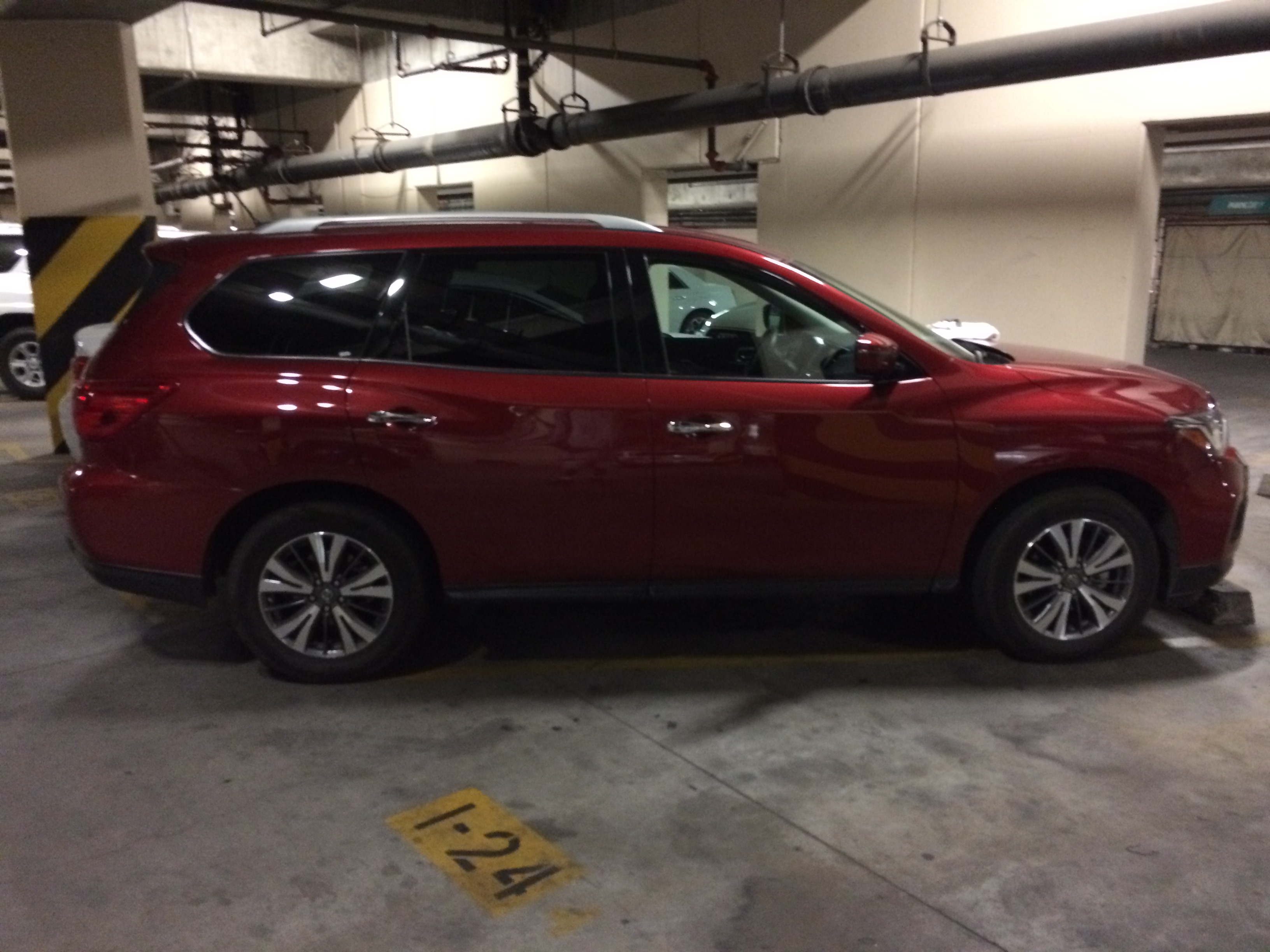
Fiesta Bowl at University of Phoenix Stadium:
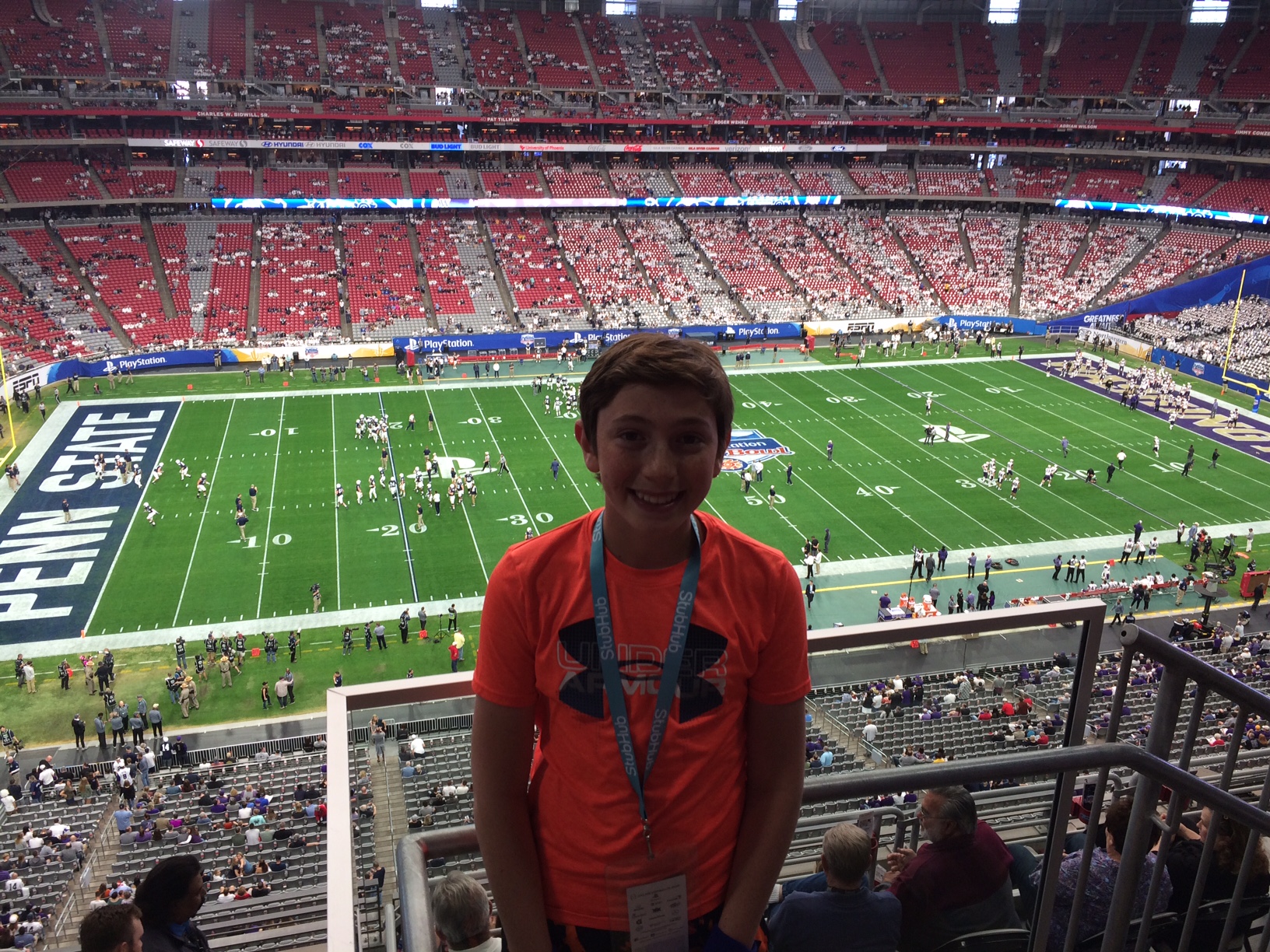
Grand Canyon, entire family:

Grand Canyon, just me:
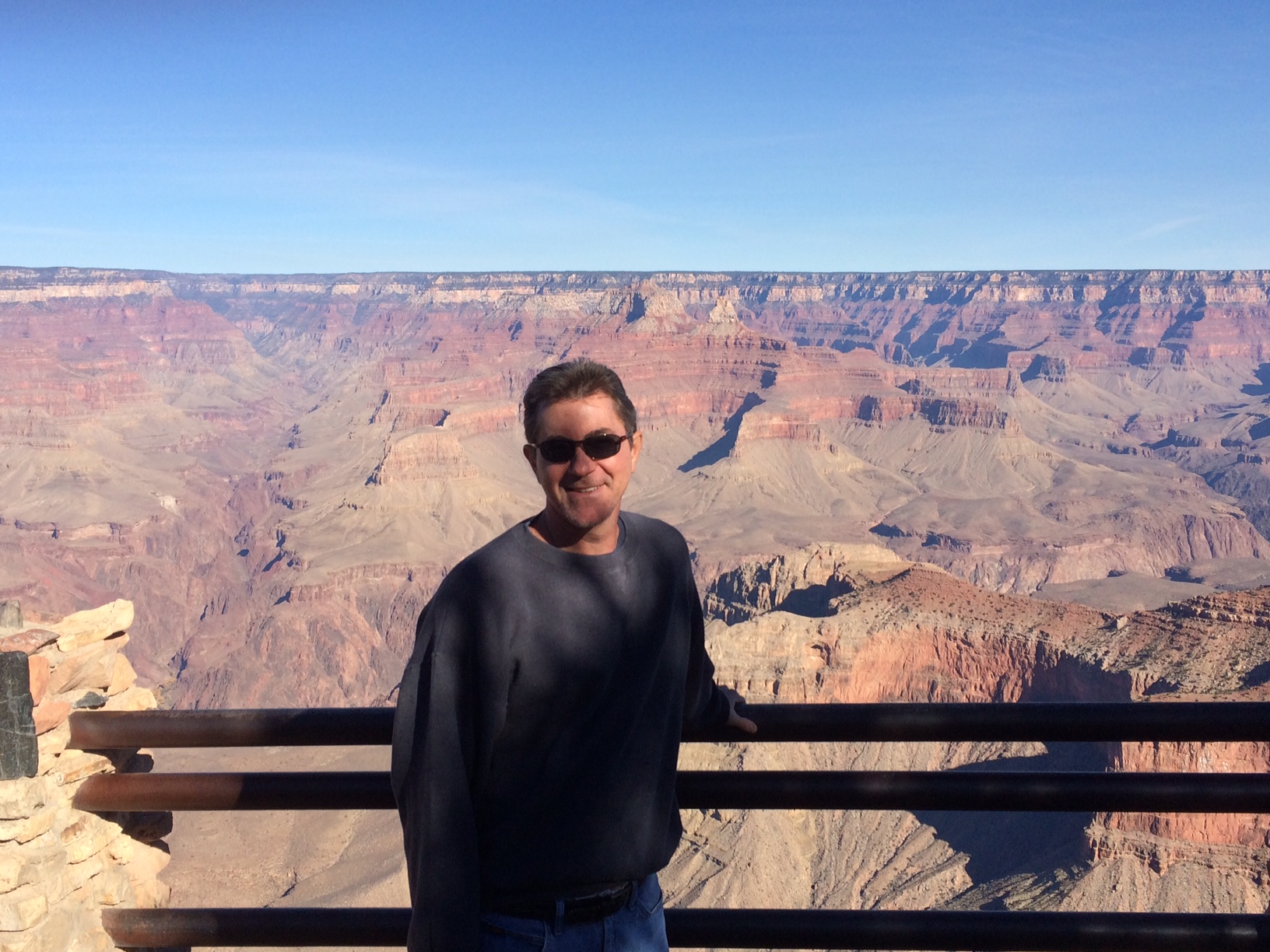
Happy New Year from Meteor Crater:

Next trip is back to Las Vegas in March.
9/20/17: Hurricane Irma
Living in a hurricane zone, one gets accustomed to close calls, near misses, and the occasional hit. My house is made of concrete, and it has metal accordion shutters and a 25-kilowatt standby generator. "Standby" means that it can power the entire house using natural gas, and switches on automatically 30 seconds after the power company abandons its responsibilities.
(The generator is thanks to Hurricane Wilma in October 2005, which did no structural damage to the house but knocked out our electricity for six days. Others weren't so lucky, waiting up to three weeks to get their power back. After that storm I said "never again" - if I have a roof, I want electricity too. Basically, having a standby generator is like having a truck engine parked in your backyard.)
By around the 4th of September, Irma was a category five monster headed straight for south Florida. Evacuations are rough and a decision not taken lightly, as evidenced by how many weaker storms and near-misses I've ridden out in my house against government advice. But this storm had the potential to wash away everything on the island, including us. We made our preparations to evacuate and planned to make the decision on the morning of Thursday 9/7.
Here we come to my first complaint. A serious storm threat results in what we call "supplies panic". This causes a run on bottled water, canned food, plywood, sandbags, batteries, gasoline, and a million other items non-hurricane residents would never think of. But gasoline may be the most frustrating of all. I keep an emergency supply of water, food, and batteries on hand in the pantry, so we don't have to do too much shopping before a storm. (Ammunition too; but that's a feature, not a bug.) Gasoline is too dangerous to store in large quantities, at least on my property. And if you're going to evacuate before a storm - or hoping to get around afterward - gasoline is mandatory. Except that about three days before a storm everyone in town starts filling up his/her tank at the same time. Gas lines stretch for hours all over the county. Worse still, stations start running out of fuel, leading to even longer lines at those that still have any. And since gas is so critical, you can't just ignore the chaos and hope to fill up later on. There is no "later on", because after the storm most of these stations will be without gas AND electricity. Like that last breath of air before going underwater, all you need is one tankful...but that one tankful becomes almost impossible to get. I wish it didn't work like this. But there I was, trying frantically to get gas just like everyone else. Fortunately both my wife and I managed to fill up before evacuating.
Hotel rooms are another scarce item during a hurricane. We wanted to evacuate to Orlando but most of the rooms were already booked. I managed to snag us two rooms at the Cabana Bay Beach Resort, which is a Universal Studios property. Not to belittle what seems like a popular tourist hotel, but the other Universal properties are much nicer. The Cabana Bay was made even more unpleasant when the amusement parks closed for the weekend, keeping everyone cooped up in their hotels. Anyhow, we packed both of our cars and left at about 6am Thursday morning, not knowing whether we would ever see our house again.
Which leads to another vital consideration: evacuation traffic. Approximately one to two million people were all leaving south Florida at the same time. Normally Orlando is a three-hour drive on the turnpike, but the turnpike is a two-lane highway prone to gridlock under the slightest traffic pressure. (There were other additional factors as well; more on them later.) But these thoughts all led me to the same conclusion: Don't take the turnpike. Instead we drove up I-95 to Cocoa Beach and then headed west. The drive took about 4.5 hours.
What I didn't anticipate on the turnpike, and what made it even worse for those who did, were the service stations located every thirty miles or so. These stations always have gasoline, or are required to by state law. This meant a miles-long line for gasoline at each one. The problem? Blocking one lane on a two-lane highway created a parking lot stretching over a hundred miles. Friends and family who left at the same time we did for Orlando were in their cars anywhere between 6.5 and 8 hours on the turnpike. Why this major highway is still only two lanes wide in one of the fastest-growing states in America, and a hurricane-prone state to boot, is a mystery to me.
To sum up, it takes a genuine natural disaster to remind us how unprepared we are for natural disasters. The chaos and shortages before and after a storm are incredibly frustrating and often dangerous. There must be a better way.
At least the amusement parks were all open on Friday 9/8. We visited Volcano Bay, the water theme park at Universal. They have a 120-foot cannonball slide, which is basically a free-fall drop. I used to ride an 80-foot cannonball at Six Flags Atlantis in Hollywood, FL back in the 1980s. I would run up the stairs twenty times and ride it over and over. With these memories in mind, I rode the Volcano Bay cannonball exactly twice. I'm not twenty years old anymore, and two trips up those endless stairs were more than enough. I can say that this old man rode the scariest slide in the park. Twice.
On Tuesday 9/12 we headed home. The storm ended up going fifty miles west of where it was initially forecast, so structural damage in our area was minimal. We got home to find our power already back on and the generator off (good). But nearly every tree in the neighborhood was damaged or destroyed (bad). This includes the mango tree we planted when my first daughter was born, which split in half. But several Miami-Dade neighborhoods were flooded by storm surge, so we came out comparatively well. Thankfully, Hurricane Irma wound up being another in a long line of Miami Beach near-misses stretching back to 1926.

Here's a time-lapse video from the 79th Street Causeway in Miami Beach. My father manages the building below the camera. Watch the first floor flood and the dock wash away.
And with that, I bid a grateful farewell to the nasty hurricane season of 2017.
8/25/17: Solar Eclipse
From 8/17 to 8/22, I dragged the family to St. Louis for the eclipse. This was my eighth total solar eclipse. The list as it currently stands:
| Oranjestad, Aruba | 2/26/98 | Success |
| Munich, Germany | 8/11/99 | Cloudy |
| Zambia, Africa | 6/21/01 | Perfection |
| Indian Ocean, Mozambique* | 12/4/02 | Cloudy |
| Mediterranean Sea, Greece* | 3/29/06 | Success |
| Iwo Jima, Pacific Ocean* | 7/22/09 | Success |
| Australia, Pacific Ocean* | 11/13/12 | Success |
| Arnold, Missouri | 8/21/17 | Success |
*Cruises
Note that there's only one U.S. destination on this list. That's because the last time totality crossed the continental United States was over Montana in February 1979, when I was a poor young pup with non-eclipse parents. You'll also see four cruises in a row; when remote locations or poor weather prospects threaten your eclipse success, the best thing to do is hop on a boat. Ships are mobile and able to adjust their itineraries according to weather forecasts. Finally, my eclipse history includes six successes and two failures, both of them due to cloud cover. If you want to know what it feels like to miss an eclipse, try imagining every pet you've ever owned coming back to life and then dying again all at once - except much more expensive.
(To see a list of this century's eclipses, go here. For details on the U.S. eclipse go here.)
Since this would be my first eclipse on American soil, I had been looking forward to it for almost twenty years. Planning for the trip began nearly two years ago. However, I didn't want to sign up for an expensive professional tour in my own country. Nor did I feel like traveling to Wyoming or Oregon, which despite the best weather forecasts are difficult to travel to from Florida, and could expect huge crowds on eclipse day with relatively few roads to carry them. The east coast (Georgia or South Carolina) was also out, due to poor weather prospects. The farthest west we could travel on a direct flight was St. Louis, which boasted a 60% chance of clear skies. So, 330 days in advance, I reserved our plane tickets and hotel and planned to drive an hour southwest of the city to a town called St. Clair on the center line.
What's changed since my last eclipse in 2012? Web-based weather forecasts are much more detailed, for one thing. I spent the first three weeks of August frantically checking long-range "cloud cover" forecasts, which are a relatively new weather-site feature. Missouri looked bad at first, then good, then iffy. Five days prior, the entire western half of the state (my original plan) started to look downright terrible. Panic, depression, and fear of abject humiliation ran wild in my fevered mind. Our children were missing the first two days of school for this fool's errand. Assuming we got clouded out, how could I face family and friends at home -- apologizing for the vagaries of eclipse chasing and saying we'll get 'em next time?
My friend Julian, who was with me in Munich (1999) and Zambia (2001), drove down from Chicago with his three boys to meet us. The day before the eclipse we made the decision that our original destination of St. Clair had no chance. So on Sunday morning I drove around east-central Missouri, about 45 minutes south of St. Louis. (St. Louis lay just outside the path of totality, so we had to drive either south or west to see anything.) I discovered a wonderful place called Arnold City Park in Arnold, Missouri. It was big and wide, with plenty of open spaces. At 5am Monday morning Julian and I decided that we had just as much chance of seeing the eclipse there as anywhere else further away. Traffic gridlock was also a concern, with apocalyptic predictions galore. (Some of these actually came true, such as the 14-hour Great American Traffic Jam between Wyoming and Denver on Monday evening.) We left our St. Louis hotel at 6am and were in line at the Arnold City Park entrance by 6:45.
I jest, of course. There was no line. Only two cars had gotten there before us, and these hard-core chasers were already set up inside. So we parked in a secondary lot all by ourselves.


The eclipse was scheduled to begin at 11:15 but nobody besides vendors showed up at the park until about 10am. Needless to say, mocking oneself is a necessary feature of eclipse chasing.
I'll skip the setup and early phases and get to the point. The weather was very good - only a few scattered clouds floating past. One of them decided to drift overhead about five minutes before total, if you can believe it. So we abandoned our empty tent and chairs and ran to the other side of the park. Rather than describe what we saw, why don't I just link to our family video on YouTube? That way you can watch me babble like Rain Man during one of the happiest moments of my life. (You can also hear my 14-year-old son curse like a sailor's parrot.) The next two eclipses are in extreme South America, and I'm planning to go in 2020.
The intrepid eclipse viewers:
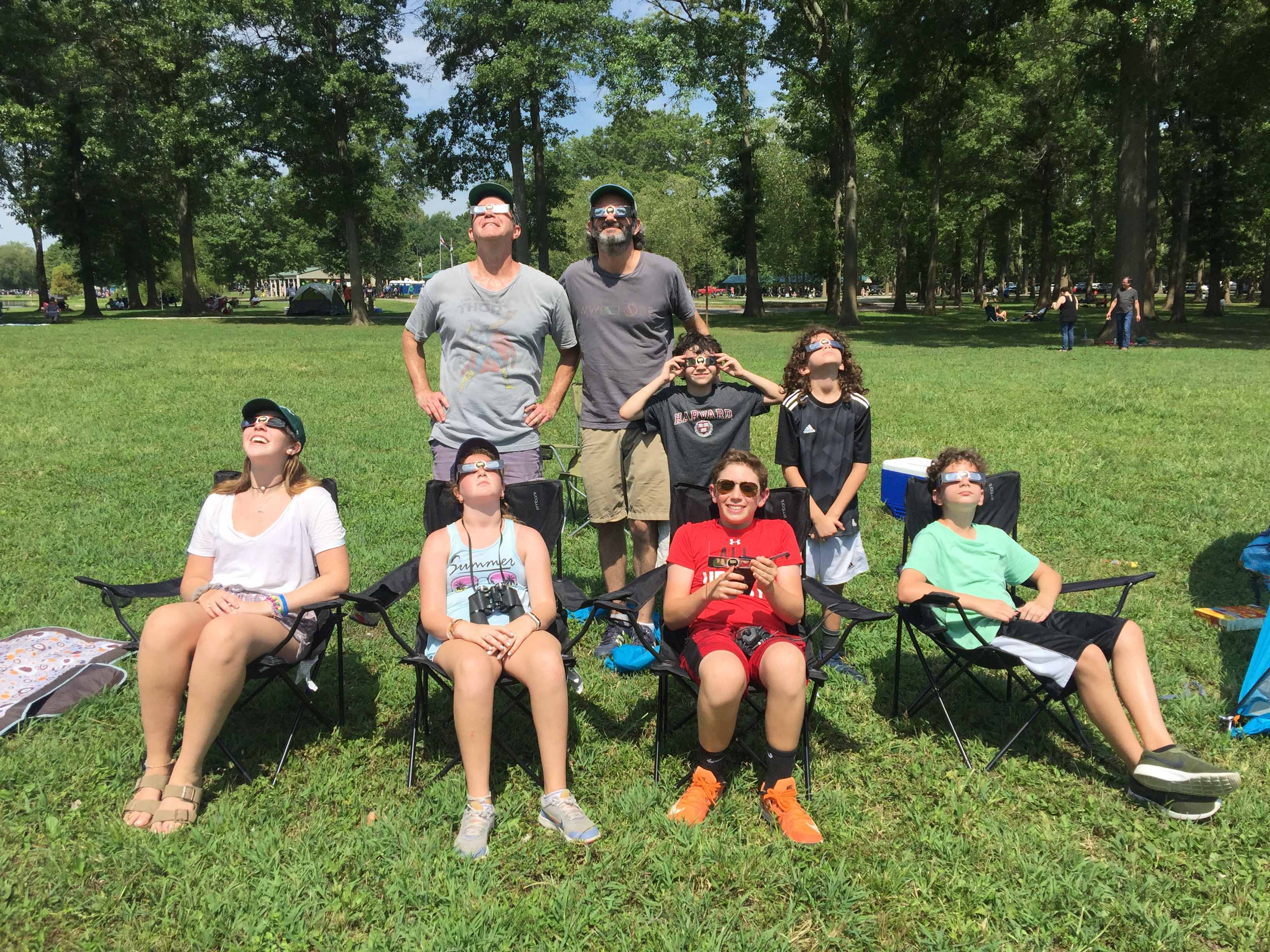
Final fun fact: After anticipating this eclipse for twenty years and planning the trip for almost two -- taking weather, location, traffic, and luck into account, all under the cold shadow of potential failure -- we actually got to see it. Meanwhile a friend of mine in Atlanta threw together a picnic basket at 11am Monday morning, loaded his two daughters in the car, and drove 45 minutes to a park in northeastern Georgia. He also saw a perfect eclipse under even clearer skies than we had. Don't tell me nature has no sense of humor.
4/15/17: On a lark, I took my son to Las Vegas for spring break. We spent five days at the Aria hotel. I usually visit Las Vegas twice a year, but never with the kids. My wife was worried that with him being under 21 we'd have nothing to do. Fortunately this was far from the case. We ate and I drank. We saw two shows, Steely Dan and Blue Man Group. And of course we visited Battlefield Vegas for a machine gun shoot. (Don't worry, no Saving Private Ryan pictures for you faint-hearted fans.) Here's my son in the Mandarin Oriental Sky Lobby lounge, which for my money has the best view of the Strip in town:

Steely Dan was a huge disappointment. My son fell asleep the moment the show began at 8pm, no doubt a combination of jet-lag and boredom. The band sounded great and Don Fagen's voice is still in good shape. But after a well-programmed opening half hour, the set list went south. I'm a casual fan from the 70s who loves the album Aja from front to back, but otherwise I only know the hits. After the first thirty minutes the band began playing deeper cuts, which works for some bands in my catalogue (Rush, Yes, Moody Blues). But to me, a lay person unfamiliar with these songs, it just sounded like adult jazz to me. A very expensive nap for my son, and perhaps for a few of the septuagenarians in attendance as well. I turn 50 this year, which made me one of the youngsters.
On the other hand Blue Man Group was close to phenomenal, especially from a kid's perspective. Very creative and innovative, with a choreographed level of complexity that was most impressive. The show was loud and fun, and there was plenty of audience interaction. It wasn't as drop-dead funny as I've heard from some people, but still very amusing. If I have one critique, it would be that the show bogs down at certain points. But this is a minor quibble. Adults will like it, while kids will adore it. Interesting observation: while I was expecting a Blue Man Army, there are actually only three Blue Men onstage for the show. The rest of the cast are musicians, ushers, and stage managers.
4/7/17: I just finished reading Raymond Chandler's The Long Goodbye for the second time. What an unmitigated pleasure. I cannot read Chandler without marvelling at his tight and masterful writing. He wrote seven Phillip Marlowe novels, and in my opinion The Long Goodbye was his best. Chandler doubled his normal book length for this novel. This allowed him to double the intrigue and character count as well. It should come as no surprise that instead of feeling bloated or overwrought, The Long Goodbye is a masterwork of detective fiction, delving deeply into the wealthy, corrupt, and seductive mess that was 1950s Los Angeles. Chandler's crooks and cops come across so darn vividly. I like to read him while I'm revising my own novels, just to remind myself what great writing looks like.
3/9/17: I don't usually read non-fiction. When I do, the topic is almost always either military history or classical history (Greco-Roman). But I just finished a fabulous memoir that has completely changed the way I look at flying.
The book was Fate Is The Hunter by Ernest K. Gann. Gann describes his role during what has to be considered the birth of aviation, starting with post-WWI barnstormers and culminating with flying's 1960s Mad Men heyday. The gripping first chapter talks about a close call with another airliner in which a mere fifty-foot margin prevents catastrophe and certain death. (Hundreds of his colleagues over the decades weren't so lucky.) Gann's tale includes lonely and dangerous trans-Atlantic cargo flights during WWII, trailblazing new routes through freezing ice and steamy jungles, and being a civil aviation pioneer when danger was the rule, not the exception. Their equipment was new, untested, and shockingly unreliable, often requiring a great pilot just to survive a flight. On top of this each plane was different in temperament and reliability, meaning that a talented pilot could take the wheel of an unfamiliar model for the first time and become a greenhorn rookie upon takeoff. The tough, wary, yet self-deprecating "pilot mindset" has never been so well-explained and deserving of gratitude. These men flew not for money or adventure, but simply because they were compelled to leave the ground. They glean tricks and vital flying knowledge from veterans, while at the same time depending on a mysterious and unexplainable "sixth sense" that saves Gann's life more than once. After reading this book you'll worship the stunning miracle of safe aviation, and you'll be amazed that anybody who ever got on an airplane before 1980 lived to tell the tale.
2/17/17: We just got back from our annual trip to Arizona. My son and I spent a week in Phoenix, with two days in Flagstaff to visit the Grand Canyon and Meteor Crater.
Our time in Phoenix was as wonderful as ever. The Phoenician is one of the country's great resort hotels. Unlike Miami, which has had a warm and boring winter, Phoenix weather in February is unfailingly gorgeous -- 57 every morning, 75 every afternoon. On Monday the 13th, we woke up at 5am and drove two-and-a-half hours to Flagstaff, where we checked into our hotel for one night. Flagstaff was much colder, around 30 degrees or so. I got to wear my "T2: Battle Across Time" jacket from Universal Studios for the first time!
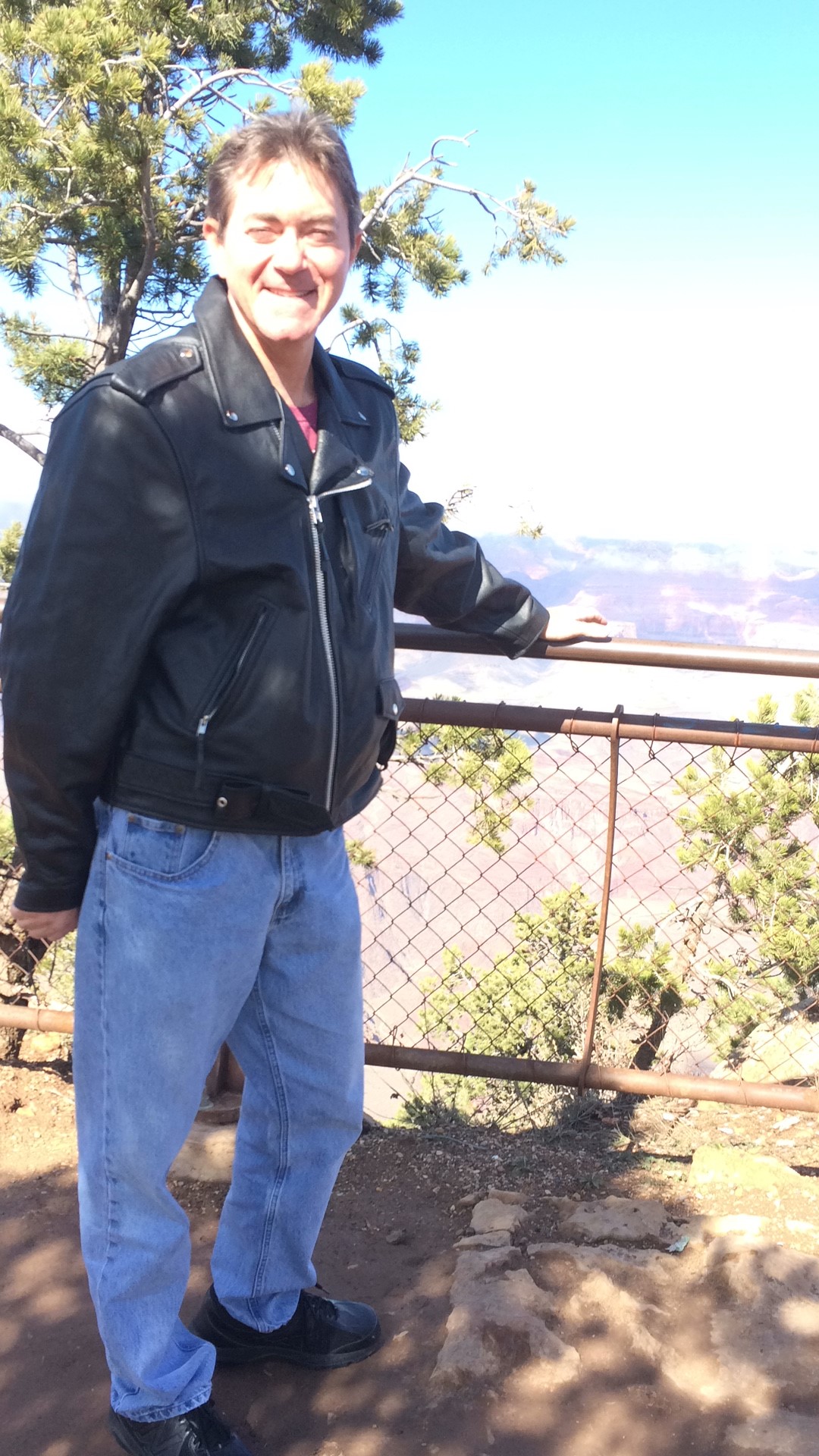
I've wanted one of these jackets since I first saw The Terminator in 1984. Over the course of two days in Flagstaff, I got one compliment and several odd looks. Maybe it's a bit Freddie Mercury, or too garish in general. But I don't care.
We arrived at the Canyon around 10:30, and it was completely fogged in. Like an ocean liner or something. Very haunting. So we hiked around a bit, and eventually the fog would roll out and clear for a while, then roll back in.

The next day we drove 45 minutes east to Meteor Crater. I last visited the Canyon and the Crater in December of 1998. Meteor Crater was even better than I remembered. My son and I were there when the doors opened at 8am. It was eerie to be the only people at the crater for almost half an hour. Very rewarding trip.
Oops -- Almost forgot the Tequila Report! We visited the Barrio Queen restaurant in Phoenix, where they serve tequila flights (blanco, reposado, anejo) for the price of one anejo. My favorite that I hadn't tried before was Chamucos Reposado. Very sweet and tasty.

2/6/17: Super Bowl hangover today. The 2016 NFL season is now over, which frees up Sundays for the next eight months. I gave up football in 2000 when I got married, but having a son (now 13) and DirecTV NFL Sunday Ticket (see below) changed that equation. Anyway, I will never understand why teams stop running the football during games. The Falcons were averaging what, nine yards per carry? Running the ball also drains the clock and wears down the opposing defense. Yet the Falcons got pass-happy in the second half, even being up 25 points. I have a theory that when offensive coordinators see their opponents passing like crazy (Brady was 43 of 62, plus an option pass by Edelman), they feel pressure to keep up. This holds true even when averaging nine yards per carry and winning by 25 points in the third quarter. I'm not sure experience cures this malady either. No doubt the Falcons are kicking themselves today, and will do so for a long time.
2/5/17: Today I'm going to address a work-related topic. But it's one that I think applies to life in general.
My day job involves taking corporate business processes - a mail room, a fleet shipping schedule, a problem reporting system - and automating them. This means moving as much of the process as possible onto a computer screen, behind which a web-based application and a back-end database store and route all the required information. The challenge arises in actually translating these real-world processes onto a digital platform.
Going into a project, I generally know very little about the process I'm automating. Fuel supplies? Mail room shipping charges? I've never supplied fuel, nor have I ever managed a corporate mail room. So it's up to the person who actually does understand these processes to collaborate with me, instill his/her knowledge, and produce a working automated system. By 'knowledge', I mean every detail of the process from start to finish, leaving nothing out. This is much harder than it sounds, and it's the main pitfall for any application design endeavor. Familiarity and human nature conspire to make it very difficult for the process person to transfer his knowledge to me in its entirety.
The best way to demonstrate this problem is with a real world example. Let's say that instead of an application designer, I'm a solar-powered alien from another planet. (Not much difference, I know.) On my planet we get all of our nutrients from our sun. I have come to Earth, and we would like to build an automated system called "eat". So I ask you, a typical Homo sapiens, to describe to me how humans eat.
Naturally we begin in your dining room. Nothing to it! you say. Eating is eating. There's some food on your plate. You pick up a fork and-
Hold on a minute, I say. What is that stuff?
Food, you reply.
What's food? I ask. So you describe the chicken and broccoli on your plate to me.
I see. So is all food made up of chicken and broccoli? I ask.
No. There are all kinds of food, you say. Vegetable, animal, and mineral.
Okay. Please describe all of them to me in detail, I say.
This takes a long time. When you're finished describing them, you again pick up your fork.
Hold on a minute, I say. Where does all this food come from?
Explaining this takes even longer than describing the food itself. When you're finished, you again pick up your fork.
Hold on a minute, I say, indicating the fork, the plate, the table, and the chair. What is all this stuff? Where did it come from? What's it made of? Explaining this takes somewhat less time than explaining the food. After you've finished talking, you again pick up your fork.
Hold on a minute, I say. You're holding a fork and knife, which I understand. But this is supposed to be a global application. There are a billion Chinese people over there, and they're eating with wooden sticks. What's up with that?
This goes on for a while. Finally, mercifully, you put a piece of chicken in your mouth, chew it, and swallow it, all of which I now understand.
And that's it, you say, sighing with relief.
Hold on a minute, I say. Where did the food go? Which of course leads to a detailed medical discussion about the digestive system, one that ends up in the lavatory. Having barely resisted the urge to strangle me all this time, you finally flush the toilet and start cheering.
Whew! Were done, you say.
Hold on a minute, I say. Where did it all go?
Not only is this a taxing and frustrating process, it also resembles a minefield. Imagine if we were to miss or skip a step, whether from laziness, incompetence, cost-cutting measures, or all three. Suddenly there's no teeth, no utensils, or (heaven forbid!) no dessert on the table. And the entire project fails. When the project fails (or requires a Phase II and Phase III to get it working properly, putting us way over budget), you come to me with a frown on your face and ask me what happened. I shrug and say, Well, I've never eaten before, and I still don't. How was I supposed to know about the teeth?
This holds true even if some other geek has already designed a "digestive system" module which we can borrow or buy. Nobody likes to reinvent the wheel, and dividing a design project into smaller modules is always wise. But it's my experience that customization is mandatory and unavoidable for almost every corporate application. (A vegetarian diet option might be required in our eating module, for example.)
Moral of the story? The biggest pitfall in application development derives from my human client's very first statement: Nothing to it! Eating is eating.
Remember how false that statement was, and you'll understand why application development is so challenging.
1/22/17: At the risk of repeating myself (and sounding like a nut), I bought another Ruger pistol today at a gun show. It's the brand new Ruger Mark IV pistol. The Ruger Standard and MKI were revered .22 caliber models from the 1950s, with a couple of upgraded models released since then. It's accurate, low-recoil, and very inexpensive to shoot (.22 Long Rifle ammunition costs less than 8 cents per round). The Mark IV model is brand spanking new, and impossible to find. When I saw it for sale at this show I couldn't say no -- there were only three of them in the entire exhibition hall, and one was used. The price was exactly what my retail store wanted, except the store didn't have it and couldn't acquire one. I brought it to the range on 2/1 and was hitting the center ring at 15 yards. Loved it.
1/18/17: I bought the new Ruger LCP II pistol on Monday, and took it to the range today for the first time. The LCP II is an updated and improved version of the LCP. It's a compact seven-shot carry pistol in .380 caliber. Florida passed its Concealed Carry law in 1987, and I've had my carry permit since 1992. Firearms equal physics, and ever since 1987 the firearm industry has been trying to squeeze more firepower out of smaller and smaller pistols. Small size is especially important living here in South Florida, since we wear shorts and t-shirts all year round, precluding shoulder holsters or other clothing-related rigs. For a trained civilian to carry a pistol in Florida, it generally needs to fit inside your front pocket. The problem is, a lot of these mini-compact pistols can't handle the forces imposed by mid-caliber rounds. They suffer breakdowns and need replacement parts, such as recoil springs. The LCP II seems much more solid. It's about an inch longer than I'm used to. But after firing it, I am absolutely thrilled with it. It's light, accurate, and comfortable to fire, and I didn't experience a single malfunction through 100+ rounds of various ammunition. Now that I've tested it and can rely on it, I'll be carrying it when I can (dependent on clothing).
1/1/17: Somnophilia now has a cover illustration, and it's a story worth telling. Check it out:
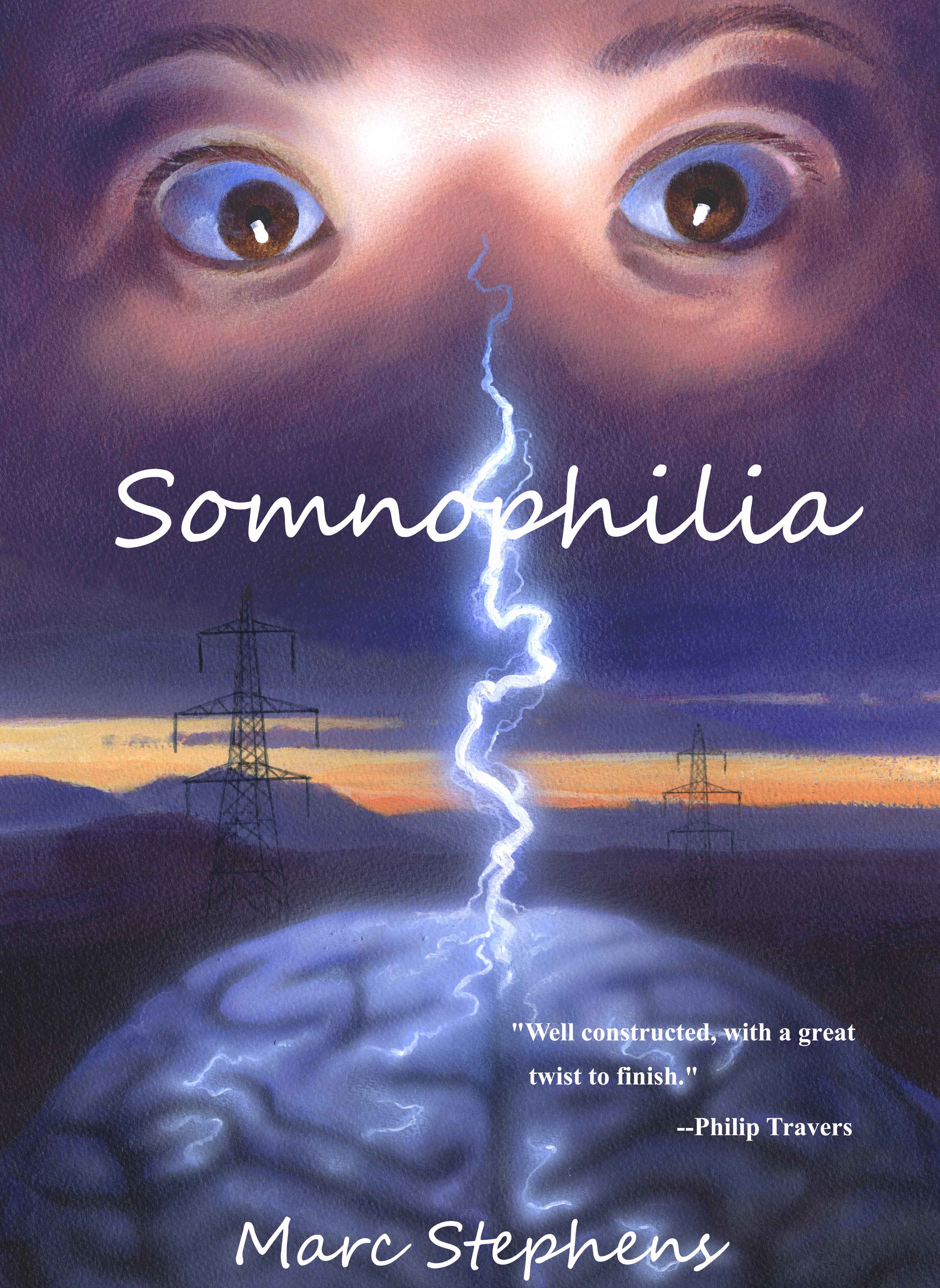
When I was a kid, I owned all of the Moody Blues' classic late-60s/early-70s LPs. (For those of you under the age of 40, an LP was a physical plastic record that played music when a device called a "record player" dragged a diamond needle across it. Literally. Oh, and the Moody Blues were a psychedelic art-rock band you've never heard of either. Try this for reference.) Back then we listened to music while staring at the album cover, which often had cool art and/or lyrics to sing along with. I loved those Moody Blues album covers -- all gauzy psychedelia, with new details showing up on each viewing. (Here's an example.) Well, Somnophilia needed a cover. So I looked up Philip Travers, the man who drew all those cool covers. Guess what? He's living in Thailand, and he enjoyed the novel. Best of all, he drew me a better cover illustration than I ever hoped to get. Having spent my childhood staring at his work, I got this 35 years later. Thanks Phil! (Side note: How do you pay somebody in Thailand without mailing a check? Answer: PayPal. It even converted my $US to British pounds sterling.)
12/15/16: GREAT tequila site to recommend: ZeeTequila.com. 20% off most mid- to high-end tequilas, an infinite selection, no tax, plus they take PayPal. They also ship your bottles like newborn babies, wrapped so well that you could drop them off a building and probably not break the bottle. I ordered four: Casa Noble Anejo, Clase Azul Reposado, Tonala Super Anejo, and Chinaco Negro. The Tonala I discovered in Arizona, and I thought I'd never find it online. They also carry Casa Cofradia Cactus Anejo, which I have yet to see anywhere else. The Chinaco Negro is absolutely divine, aged like a mid-level single-malt Scotch.
12/11/16: Took my son to the Cardinals/Dolphins NFL game today at Hard Rock Stadium. I haven't set foot in this place since 1999, when I gave up on the Dolphins and sports in general. This lasted until I had a son. Anyhow, we are Arizona Cardinals fans thanks to Kurt Warner's sojourn there in the late 2000s. What was supposed to be a great Cards season has instead degenerated into a misbegotten mess, whereas the Dolphins are enjoying a major turnaround from a poor start.
My brother was nice enough to take us. His seats are covered from the rain, but are still in the direct sunlight, much like our old seats at the Orange Bowl back in the 70s and 80s. Yes, it did rain. But the main issue I want to address is why the NFL stadium experience has lost its luster. My brother's four club seats cost $210 apiece, or over $8000 for an entire ten-game home season. The stadium is crowded (of course), has horrendous parking, and is pumped to 110 decibels with terrible music between every play. A football game only features about fifteen minutes of actual football, the rest being taken up by the forty seconds between plays, plus commercial and halftime breaks; this means sitting in your seat doing nothing for the lion's share of three-and-a-half hours. These seats also make airline coach class look roomy, scrunching my 6'1" frame into my chin and forcing the whole row to stand up whenever anyone comes or goes. That's even before the heat and rain of tropical Florida, which make sitting outside a challenge most of the year. Compare this ordeal with my DirecTV Sunday Ticket package on my satellite TV at home. I paid $200 total for the entire season. This gives me every game every Sunday, in HD surround sound, in the comfort of my own home. Even better, there are no commercial breaks -- with eight games on at once, I am free to flip around all day long. I also don't have to leave ten minutes early to save an extra hour in traffic. So financially, temporally, and comfort-wise -- not to mention my status as an aging curmudgeon -- there's really no comparison.
I went almost twenty years between visits to Hard Rock Stadium. Suffice to say, I doubt I'll be back for at least another twenty.
12/9/16: Visited the indoor range yesterday. This means no centerfire rifles. I brought two carry pistols (PSP .25 cal and MPA .380 cal) and my Thompson .45 cal rifle. The .25 fired great, as it always does. The .380 started out fine but then began failing to feed -- the cartridges wouldn't fit into the feeding ramp! I have no idea why this happened. I've owned this pistol for about one year and love it. It's either a fouling issue, which I doubt, or a problem with the barrel itself. I contacted MPA and will probably send the pistol back to them for warranty repairs. (UPDATE (12/10/16): I visited my favorite gun shop, where Fred spotted a tiny sliver of metal embedded in the barrel's throat -- probably from a faulty cartridge case. I dremeled it away and the pistol is feeding again.)
The Thompson is so much fun to fire. I have a 50 round drum and two 30 round stick magazines for it. (The drum cost me over $400 twenty years ago, when these items were very hard to find. I have no idea whether the prices have gone down or up since then.) The Thompson is known as the Gangster Gun, because it was the weapon of choice for criminals back in the '20s and '30s. If you've seen "Mobsters" or "Public Enemies", you've seen Thompsons. Although released in 1921 and modified in 1928, the Thompson was an important weapon during WWII as well. Tom Hanks carried one in "Saving Private Ryan". Neat trivia: Although the drum holds more rounds, the stick magazine was used during the war because the cartridges made too much noise swishing back and forth inside the drum, giving away troop positions. Another difference was the forward hand-grip, which was removed and the barrel shortened for the wartime version. Of course these versions were also fully automatic, while mine is a semi-automatic replica. My replica weighs 13 pounds (!), which is heavy but also means zero recoil when firing a pistol round like the .45. Anyhow, the drum is circular-spring driven and less reliable, and jammed on me three times. This may have been the bolt's fault, which I haven't cleaned in a year. I did clean it yesterday after coming home.
Final points on the Thompson: First, as with most firearms, a physics lesson. A .45 caliber bullet typically weighs about 230 grains and travels about 850 feet per second out of a four-inch barrel. However, each additional inch of barrel adds about 25 fps to the bullet's velocity. So with its 16-inch barrel, the Thompson revs up a .45 caliber bullet to about 1150 fps, which seriously raises the muzzle energy.
Secondly, this is a very politically incorrect weapon! It serves no hunting purpose, and the sights are utterly superfluous. Although it can be reasonably accurate at medium range (up to 100 yards in my experience), the full-auto version of this weapon was designed to clear a room, and fast. That's it.
11/28/16: Had lunch yesterday with my 90-year-old cousin D from New York. (His wife is actually my father's cousin.) This man spent 1944 and 1945 slogging through the battlefields of Europe, and is now a rich successful businessman with great-grandchildren. Of course he made it to 90. If Hitler couldn't kill him, what can?
D has a German Luger that he took off a dead Nazi inside a pillbox along the Siegfried Line in western Germany. He also brought home a .30 caliber M1 carbine from the war. We have to assume that D will not be with us very much longer. Time spent with D (and veterans like him) may be the most valuable time that I know of.
11/25/16: I am a serious tequila maven. At the family Thankskgiving yesterday, I brought along Avion 44 Reserva for my wife and 1800 Milenio for me. The Avion is lighter and sweeter, while the Milenio smells and tastes like a mid-range Macallan single-malt Scotch (18 for example). FYI, my favorite #1 tequila for the past few years has been Clase Azul Reposado, a sweet honeyish tequila which tastes like the nectar of the gods.
11/6/16: Yesterday was my son's Bar Mitzvah. Here's the speech I gave to him. If you like that one, here's another speech to my eldest daughter two years earlier.
8/10/16: Kids returned from summer camp today. Two weeks without them is great; seven weeks stinks. Very glad they are back.
8/3/16: Just finished four days in Las Vegas. I went in the summer because I needed the air miles on American before they changed the award rules on 8/1. Thursday was 117 degrees. "Dry Heat" nothing -- at 117 your eyeballs burn while you are outside. Evening cooled off to about 108. Good thing the resorts are air-conditioned.
Friday night I went to see Duran Duran at the Mandalay Bay. I was a casual fan back in their MTV heyday but had never seen them live. Here's my Ticketmaster.com review. Hint: I liked it.
"If you check my other reviews, you'll see that I don't rave about concerts very often. My last rave was probably second row at the Kiss reunion tour in 2000, long before I was buying my tickets on Ticketmaster. (Other raves, in case you're still reading: The Who in Miami,1989; the Alarm at Bryant College in April 1986.) I liked DD well enough in their MTV days, but have never seen them live and was probably more of a Fixx fan at the time anyway. However, this show absolutely blew the ceiling off the place.
It helps to be surrounded by middle-aged groupies shouting every lyric along with the band, granted. But this was more. I haven't seen a song performed onstage that I would label 'unforgettable' in many years (Yes playing all 21 minutes of "Nous Sommes du Soleil' for the first time since 1975; Roger Hodgson singing 'Dreamer' live along with the audience like the old days). And 'White Lines' was already a classic when DD covered it back in the 90s. But their rendering here was volcanic. I tried to stand still and failed. Miserably. It made me want to hear the song 100 times in a row.
I was also impressed with Simon's tales of the music industry. I had no idea it was Nile Rodgers who spiced up 'The Reflex' for the band back in the mid-80s. Then Nile himself came onstage and showed just how much influence he had on the band as their sometime producer.
In fact, if I were to praise this show in the proper terms: This was the first concert in many years that I didn't check the time and want to finish up. The band closed with 'Save A Prayer' and 'Rio', and had they announced 'What the hell, let's play the entire show again', I would have stayed glued to my seat. I honestly wish they had. Take it from a pompous former music critic: Do not miss this show."
On Thursday I took a trip to Battlefield Vegas. I usually visit another machine gun range when I'm in town, but I really wanted to fire a BAR (Browning Automatic Rifle, .30-06 caliber), which my buddy Darius' range does not have. Most people want to fire sleek modern weapons at these ranges. Instead I always choose the Saving Private Ryan World War II package. To be honest, the BAR was just too much gun for me. This is the weapon Ed Burns carried in that film. It's huge, and more of a bipod squad rifle than a solo rifle. The .30-06 is also a more powerful cartridge than I prefer. One cool ego thing -- this range is staffed by ex-soldiers, ex-Marines, and ex-Special Forces personnel. These guys & gals must LOVE working here. Anyhow, my host asked if I wanted him to snap a few pictures of me with the Thompson or M1 Garand. Most of his clients are city folk or Europeans who have never held a firearm before, and they want mementos of their visit. I demurred, which I think impressed him.
Side note: If you want to meet the Einstein of modern firearm engineering, you need to read about John Moses Browning, the inventor of the BAR. Put it this way -- the man's been dead almost a hundred years, and yet most modern weaponry still operates on his patents.
